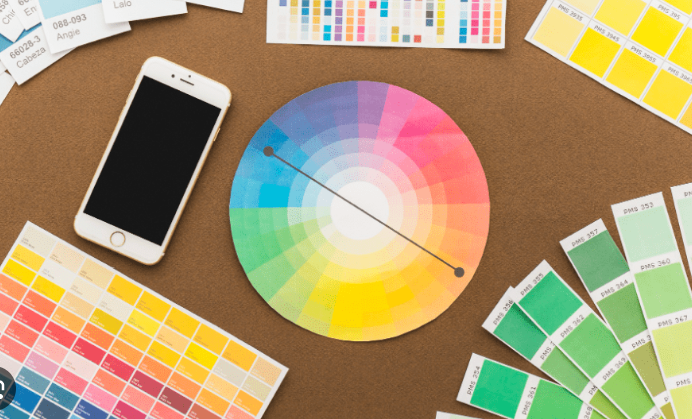This guide will assist you in selecting the ideal colour scheme, whether you’re creating a brand for a brand-new website or reconsidering the palette of an existing website. We’ll walk you through the best colours for websites and help you choose one that complements your site’s personality and aesthetic.
Ultimately, colour is a significant aspect of brand identity. Have you ever observed that the majority of fast-food restaurants use red and yellow in their logos? Because together, they promote both hunger and sociability. Orange denotes sociability and amusement, blue denotes dependability, green denotes freshness and nature, and black denotes luxury or elegance.
Colour can influence the user’s perception of your brand, as well as their emotions and behaviour. Here are some guidelines for selecting the appropriate colour scheme for your website:
1. Learn the fundamentals of colour psychology
The importance of colour psychology in marketing cannot be overstated. It would take far too long to go over every detail, so here are the most essential fundamentals.
Colour associations are highly potent. We acquire them as neonates, and they typically persist throughout our lives. These associations are often subliminal and instinctive.
These associations are reasonably universal in nature. Everyone, for instance, learns to associate green with nature and foliage and yellow with the sun.
Nevertheless, some are cultural. One study found that Americans associate envy with the colours black, green, and red, while Russians associate envy with the colours black, purple, and yellow.
2. Become familiar with colour theory
Colour theory is the scientific study of how colours function. The extended version is more difficult to convey; there are entire college courses devoted to it! However, there are a few basic concepts you can learn to improve your understanding of colour for website design.
You must first comprehend primary, secondary, and tertiary colours.
Primary colours cannot be created by combining any other two colours. Red, yellow, and blue are the three fundamental colours.
Two primary colours are combined to create secondary colours. For example, mixing blue and yellow (two primary colours) produces green (a secondary colour).
Tertiary colours are created by combining two adjacent colours on the colour wheel: a primary and a secondary. combining blue (primary) and violet (secondary) creates blue-violet (tertiary); for instance, combining blue (primary) and violet (secondary) creates blue-violet (tertiary).
3. Consider blending colour combinations
The objective is to choose a colour scheme for the website design. What does this entail? You are searching for a pleasing colour combination. Depending on the number of colours you choose to use, your colour scheme may include multiple colour combinations.
When considering colour combinations for your website, it is essential to comprehend these colour nuances. You must understand why certain colour combinations work and how to modify colours to improve your scheme.
Colour theory is very useful for determining what colour combinations are harmonious. Therefore, when it comes to choosing the colours for your palette, there are a few more sophisticated aspects of colour theory that can assist you in determining which colours will work best.
Earlier, I discussed how colours are combined to create new colours, but we must also examine how colours are combined.
Five primary colour combinations exist: complementary, divided complementary, triads and tetradic, analogous, and monochromatic.
Complementary colours are opposite each other on the colour wheel. One warm colour and one cool colour comprise a complementary colour combination. Red and green is a popular complementary colour combination.
Split complementary colours consist of a base colour and two colours contiguous to the base color’s complement.
Triadic and tetradic colour relationships are comparable. Triads consist of equally spaced colours on the colour wheel, such as red, blue, and yellow. Tetradic colours, such as red, green, blue, and orange, are constituted of two pairs of complementary colours.
On the colour wheel, similar hues are adjacent to each other. As a consequence, analogous colours, such as green and yellow-green, are extremely similar.
In conclusion, monochromatic colours are variations of the same hue. This is achieved through the use of tints, hues, and tones.
Consider these colour schemes as your instruments. Since these colour combinations all work, you won’t have to stress about mismatched hues.
Now that you are aware of the precise colour combinations you can use, you can consider how to combine them to create a dynamic, engaging colour scheme.
4. Keep it basic
This may appear as though it could become complicated, but it shouldn’t. Instead, when selecting your colour palette, consider simplicity. Frequently, the eye becomes confused by a colour scheme that is overly complex and cluttered.
Keeping things simple has two important advantages.
Possibly the greatest advantage of simplicity is that it effortlessly ties together a colour scheme. If you use only a handful of colours at work, everything will appear cohesive. (Well, at least if you’ve used one of the previously mentioned colour combinations.)
A further advantage is that observers do not have to exert much effort to comprehend what is occurring. This is a characteristic of an excellent website. If you use excessive colour, your users will become more perplexed.
5. Contrast your colours
Next, consider contrast. It is one of the most important elements of excellent design that you can use when designing the colour scheme for your website.
Due to the fact that contrast creates impact. Specifically, contrast can attract the reader’s attention to specific areas of the page.
Therefore, if you want your users to notice something, it should contrast with the remainder of the page (or at least with the design elements that are closest to it).
6. Incorporate your brand
Consider how your brand will interact with your colour scheme. There is a good chance that certain colours are already associated with your brand. In this case, you can use your existing colour palette to construct the colour scheme for your website.
However, you may have to adjust your brand’s colour scheme. If one of your selected colours has a negative connotation, you may wish to select a different colour.
Consider the colour associations people have with the hues you’ve selected. Are these associations consistent with the values upon which your brand was founded?
Colour improves brand recognition, draws attention to essential website elements, and influences how people perceive a website. varying colours evoke varying emotions in people, so it is essential to select the appropriate hues. White space, contrast, and excellent colour schemes are essential components of a well-designed website.
According to data collected by Kissmetrics, colours affect how we perceive the products we purchase. Consider the hues red, orange, black, and royal blue if you wish to attract impulse purchasers. However, shoppers on a budget will find navy blue and teal enticing.
I recommend beginning by selecting three colours for your palette: a primary (or dominant), secondary, and accent colour. Then, employ these colours using the 60/30/10 rule to your website design. 60% of the colour used should be the primary colour, 30% the secondary colour, and 10% the accent colour, according to this rule.




